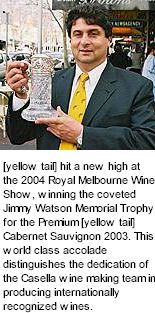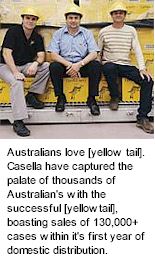


Filippo and Maria Casella emigrated to Australia bringing with them their know-how acquired through three generations of grape-growing and winemaking in Italy. Recognising the potential of the region, Filippo purchased a farm in the town of Yenda, New South Wales. After selling the grapes from his farm to local wineries, he decided in 1969 that it was time for a new generation to put its winemaking skills to use, and the winery was born.

John Casella, one of Filippo and Maria's three sons returned to the family business in 1994 and embarked on an ambitious expansion to build a new winery with the mission to blend old world heritage and new world technology. In 2002, Casella brought in Alan Kennett as Chief Winemaker. Alan previously worked with a number of other successful Australian wineries.
Based in the Riverina and operating as a winery since 1969, Casella Wines initially concentrated predominantly on the export market, and is now a key player in Europe, Asia, the UK, USA and Canada. In September 2003, Casella launched into the domestic market with [yellow tail] which has proved a remarkable success in Australia.
The [yellow tail] brand has become the most successful launch of an Australian wine brand in the history of the Australian wine industry. State of the art vineyards and wine production together with a solid infrastructure has allowed Casella Wines to maintain key markets and develop growing markets. In terms of volume, export sales have exceeded 12 million cases since 1998, and since June 2001 have seen considerable growth with the introduction of the export specific brand [yellow tail]

The Shiraz is currently ranked as the No.1 selling Australian 750ml red wine in the USA with the [yellow tail] Merlot being the No. 1 selling Australian Merlot in the USA. The wines are enjoyable, showing generous fruit flavours and excellent drinkability. Perfect anytime these wines excel when served with food.
[ yellow tail ] remains the most successful launch in the history of Australian wines. A global phenomenon and one of Australia's most recognized exports, [ yellow tail ] has proven to be the most formidable ambassador in Australian wine history. [yellow tail] wine is exported to over forty countries around the world. Over 2 million glasses of [yellow tail] are drunk around the world every day! The secret to the sucess is quality, selection, and the highest standards. John Casella hand selects only the best parcels for the Yellow Tail wines. He looks for flavour, acid balance and colour. His goal is to produce a premium, fruit- driven wine with the added complexity of French oak ageing, while maintaining the softness and drinkability of [yellow tail]. The ongong achievements extend to the international wine competitions circuit. [yellow tail] Limited Release 2004 Shiraz was awarded Gold at the 2007 inaugural Syrah du Monde competition, recognising the best Shiraz wines from around the world.
Each vintage, parcels of fruit are selected from Australia's very best growing regions. The warm climate of the Riverina region provides the backbone with big, ripe concentrated fruit flavours. Fruit from the cool climate regions contributes crisp acidity, elegance and finesse.
